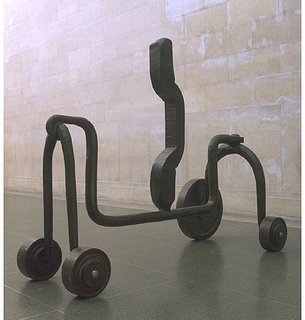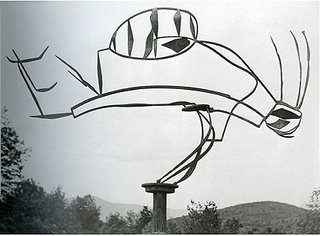
Cubi XIX, 1964
Stainless Steel Tate.
Purchased 1966 © Estate of David Smith/ VAGA, New York, DACS 2006
American Abstract Expressionist Sculptor
1906-1965
David Smith was born in Decatur, Indiana, in 1906. His mother was a school teacher and a devout Methodist; his father was a telephone engineer and part-time inventor, who fostered in his son a reverence for machinery. After his family moved to Paulding, Ohio, in 1921, Smith developed an interest in art, taking a correspondence course in drawing under the auspices of the Cleveland Art School. Although he spent one year at Ohio University in Athens, Ohio, Smith felt that the studio art curriculum there did not offer the stimulation he sought, and he subsequently dropped out in the spring of 1925. During that summer, he worked as a welder and riveter at a Studebaker automobile factory, where his understanding and love for industrial materials and techniques took root. Much of this rudimentary training proved essential to Smith's career as an artist.

Wagon II, 1964, Steel sculpture.
1999 © Estate of David Smith/ VAGA, New York, DACS 2006
Smith moved to New York in 1926 and enrolled in classes at the Art Students League, where he met Jan Matulka, a Czech abstractionist. Through Matulka, Smith became familiar with the work of Piet Mondrian, Wassily Kandinsky, and the cubists. By the early 1930s, Smith had begun to incorporate found objects such as shells, bones, wood, and wire into his paintings, adding depth and transforming them into sculptural reliefs. Soon thereafter he began constructing welded steel sculptures, and it is for these works that Smith is best known.

Smith fingers ~ David Smith:
A Centennial is at Tate Modern, London, from November 1 until January 21 2007
Smith developed friendships with other avant-garde artists, including Willem de Kooning, Arshile Gorky, and John Graham. Graham, a painter and critic, introduced Smith to the welded sculptures of Julio Gonzáles and Pablo Picasso, which made a tremendous impression on the artist. By 1934 he had settled into a "studio" at Terminal Iron Works, a foundry in Brooklyn, where he constructed innovative and remarkably diverse sculpture from used machine parts, scrap metal, and found objects.

The Forrest The Forest, 1950 Painted steel, on wood. Raymond and Patsy Nasher Collection, Dallas © Estate of David Smith/ VAGA, New York, DACS 2006
Throughout his career Smith's largely abstract work evoked the figure. Often executed in series, his sculptures fully explored particular ideas about materials and composition. In 1965 David Smith's career was cut short when he died in a tragic automobile accident at the age of fifty-nine.
After Smith died in a car crash in 1965, the painter Robert Motherwell wrote an epitaph: 'Oh David, you were as delicate as Vivaldi and as strong as a Mack truck'
David Smith is widely regarded as the most important American sculptor of the 20th Century. I really hope you enjoy his works as much as I do. Please visit the links that I have provided, there is much more to his work than what I have posted here.
Have a great day everyone!
Labels: Art
N Posted by Rain at 11/30/2006 01:34:00 PM


posted at 5:03 PM
Those are some pretty funky sculpturs.

Rain posted at 3:36 AM
rav'n, David Smith did beatiful work didn't he? If you follow the link to the San Fransico Museum there are some wonderful photos there!
Hi Sheila!
Have a good weekend and give extra hugs to your young ones for me okay?

cube posted at 10:33 AM
I'm strangely fond of the Cubi XIX
;-)

Frances D posted at 4:38 PM
Beautiful - I especially liked the forest.
Thanks for sharing,
Frances

posted at 5:00 AM
"Pillar of Sundays" is in the IU Art Museum. He said it was inspired by the events, rituals, foods and sounds associated with the Sundays of his teen years. (He was born in 1906.) It's described in Wikipedia as "ambiguous, suggestive, and intriguing".
http://upload.wikimedia.org/wikipedia/en/1/1e/PillarOfSundays.jpg
Perhaps - but I was a teenager in that same church a half century later. I find no ambiguity - but I marvel at his ability to sculpt sounds and smells.
I knew Golda, his mother. You'd never guess they were related. Where David was bold, she was retiring. Where he was outspoken, she was quiet.
Flat art gets reproduced in calendars, and on T-shirts. If sculpture was so easy reproduced, a lot of people would jog while wearing a David Smith....



« Home




![]()
![]()





